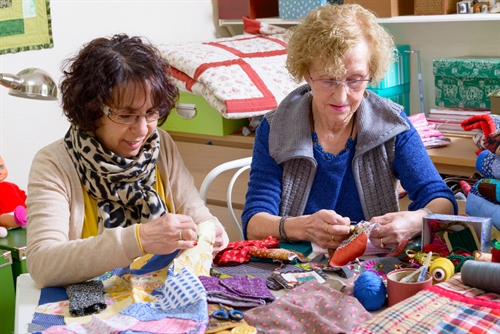Buying supplies for a fibre-craft hobby, whether it’s knitting, stitching, dress-making or crochet, is for many people, a key part of the fun. But what do you do when your craft stash starts to get unmanageable?
Busting your craft stash
The first step in organising your craft stash should be to get rid of any supplies, whether fabric, yarn, notions or buttons, that you know you are never going to use. Maybe they’ve fallen out of fashion, or maybe you just don’t like them any more. Whatever the reason, don’t give valuable storage space to fibres that you don’t love. Make use of Ebay, local selling sites or a boot fair to shift your unwanted craft items. Some charity shops specialise in craft goods, too. If you often pick up pretty craft bits from a charity shop, ask if they would like a donation.
You don’t need to see your craft stash
Sometimes putting yarn, fabric or other paper supplies away for a time will allow you to view your materials through fresh eyes. If a crafting supply is not appealing but you do want to keep it, put it in store. With any luck, you’ll be surprised by some fresh inspiration. It’s a good idea to set a calendar reminder so you remember to take it out.
Store your crafting kit for the off-season
Every activity has its season, and some people find that they spend less time on a crafting hobby during the summer as other outdoor activities become more enticing. Or perhaps like some knitters, you can’t bear working with warm wool when the weather is hot. And then there are crafting materials suitable for Christmas or Easter. It makes sense, then, when you know that you won’t use a tool, a fibre or a fabric for six months or a year, to put it in storage.
Protect your fibres and yarns from moth
Unfortunately, clothes moth infestations are becoming more and more common, according to the Natural History Museum. The moth’s larvae eat wool and silk as they grow. If you see the golden-winged adults in your home, take steps immediately to control them, or your natural fibres will be reduced to a mass of fluff.
If you know you have a moth problem, put new yarn and natural fibres into storage to protect them. Isolate any second-hand yarn in an airtight bag until you are sure it is free from moth. You won’t be able to claim for moth damage if the infestation was present when you moved your yarn into storage, so make sure that any fibres and woollen fabrics are free from moth before you store them. Some of the tips in our post about Storing heirloom textiles also apply to craft materials.
Protect your precious crafting materials
And, don’t forget to protect your stored craft items with self-storage insurance. Self-storage insurance is mandatory for most reputable storage companies. In many cases it is just added to your bill – but you can shop around for a better deal, so check how much you are paying each month and get a quote from Store and Insure to make sure you’re not overpaying.


